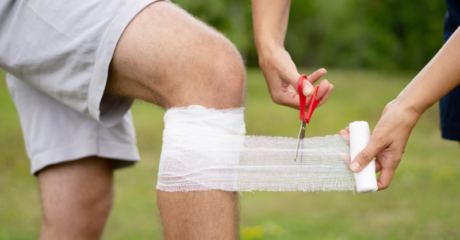
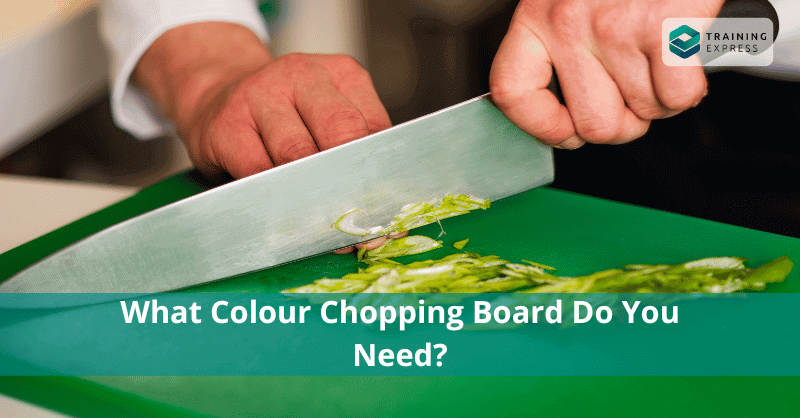
You can’t imagine a kitchen without a chopping board. No matter how big or small the kitchen is, chopping boards are an irreplaceable tool in the kitchen. But did you know how important the chopping board colour is to ensure food safety? If not, stay tuned. This blog will tell you all about chopping board colour and their significance.
Table of Contents
What is a Chopping Board?
A chopping board is a wooden or plastic board where food is placed and chopped. Chopping boards come in different shapes, sizes, and colours. From homes to huge commercial kitchens, chopping boards are essential for every kitchen.
Why are Chopping Boards Used?
Copping boards are used to protect the food, the surface you are working on and even the knife. It protects the food, such as the meat and vegetables, from the dirt on the table’s surface or the kitchen counter you are working on. Also, It keeps the table and kitchen surface protected from the knife’s scratches and prevents the knife from going blunt.
Why Use Colour-Coded Chopping Boards?
When you use the same utensils for meat, vegetable, fish, etc., there is a great risk of cross-contamination. Especially on the cutting board, the bacteria from different food groups build up on the cuts and scratches and transfer from one food to another. Hence, it is important to use different cutting boards for different types of food to ensure food safety.
But if the colours are the same for every board, it will get confusing for you to identify which board you should use. Thus, the solution is colour-coded chopping boards. When you allocate a certain colour to each food group, you will be able to reduce the possibility of cross-contamination.
How Many Colours of Chopping Boards are there?
There are mainly seven different colours of chopping boards. These colours are
1. Red for raw meat
2. Green for fruits and vegetables
3. Blue for raw fish
4. Yellow for cooked meat
5. Brown for root vegetables
6. White for dairy and bakery
7. Purple for free-from products (for example, gluten-free)
What Colour Chopping Board do I Need?
What colour chopping board you need will depend on the food groups you work with. If you want to cut vegetables, you will need a green board. But if you are cutting raw meat, you will require a red one. Keep a chopping board with each colour in your kitchen so that you don’t have to worry about cross-contamination.
What are the Types of Chopping Boards and Their Uses?
Each colour has a different significance for the chopping boards. Here is a brief explanation of different coloured boards and their uses.
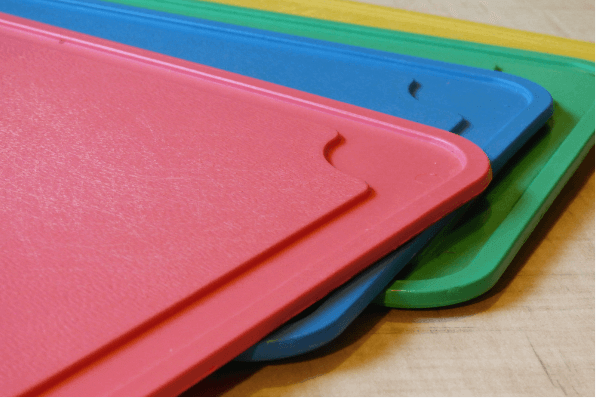
Red Chopping Board
The red chopping board is for raw meat. While you work with raw meat, you must use the red board. Raw meat consists of dangerous bacteria such as E.coli, Salmonella, and more. Thus, it is important to ensure the red board is only used for raw meat.
Yellow Chopping Board
The yellow chopping board is for cooked meat and poultry products. For example, chicken, boiled eggs, turkey, duck, steak, lamb, etc. These products may not contain as many bacteria as raw meat, but you must clean them thoroughly after you are done chopping.
Blue Chopping Board
The blue chopping board is for cutting raw fish, seafood and shellfish. After cutting the fish, you must clean the board properly, or tons of bacteria will start to grow inside the deep knife scores.
White Chopping Board
The white chopping board is for food products like cheese, tofu, bread and other bakery products. As the white-coloured board is for dairy products, you must give it a good wash before using it, as many people are intolerant to dairy products.
Green Chopping Board
The green-coloured cutting board is used for green vegetables, herbs, nuts, and fruits. You can use this board for chopping garlic, onion, and chilli.
Brown Chopping Board
The brown chopping board is for unwashed vegetables or root vegetables such as potatoes, carrots, reddish, etc. Unwashed vegetables can have dirt, mud, and pesticides on them, and sometimes washed root vegetables can still have dirt. That is why a separate board is used for root vegetables and unwashed vegetables.
Purple Chopping Board
The purple board is for the Free-from products. Many people are allergic to different food. For example, some are allergic to nuts or dairy products. The purple board is used to cut food products free from allergens. You can also use the purple board to cut elements you don’t want in your food. For example, gluten.
When Should I Replace a Chopping Board?
There are two ways you can determine if it’s time to change your chopping board.
1. First, when you see your board has deep knife scratches.
If there are deep scores on the board, you won’t be able to clean it properly. As a result, bacteria will grow and multiply within the scores.
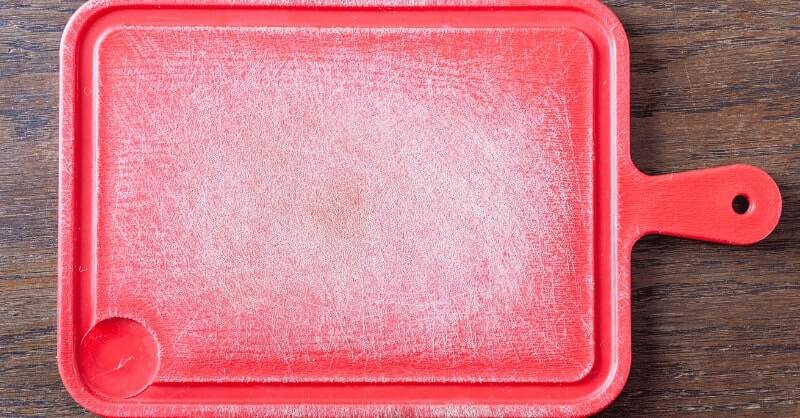
2. Second, when a chopping board becomes old and loses its shape.
After the cutting board losses its shape, it does not sit flat on the surface. As a result, it can slip and cause accidents. So, when you see that your chopping board is wobbly, change it right away.
Benefits of Using a Colour-coded Food Preparation System
Colour-coded food preparation system plays a significant role in preventing cross-contamination. In large commercial kitchens or restaurants, the environment is very hectic. Thus, having a colour-coded system allows the cooks to ensure food safety. It helps the workers easily find the right utensil for each food group. Hence, the colour codded system helps ensure food safety without creating confusion.
Can You Use Other Chopping Board Colour?
If you want, you can use different colours from the colour coding system. For example, you can use red coloured boards for vegetables. However, you can’t use the same board for different food groups. Moreover, you must keep track of what colour you have allocated to each food group.
Cutting Boards: What EHOs Will Look For During an Inspection
When the EHOs inspect your kitchen, they will check your methods of keeping the equipment separate from different food groups. In addition, they will look into your Food Hygiene Management System and investigate if you are maintaining hygiene in food preparation. Here are a few more things they will look for during the inspection
- Whether you are using colour-coded equipment to avoid cross-contamination
- Are the cutting boards clean and kept in good condition
- Do the kitchen staff know about the colour-coded system
Choosing & Purchasing The Right Colour-Coded Equipment
When you buy colour-coded equipment for your kitchen, make sure they are good quality, safe for food, and easily washable. Thus, it is better to buy stuff from a trusted source who can check all the boxes. Furthermore, while buying the boards, remember not to buy wooden boards. Wood absorbs the liquid from the food and allows bacteria to grow.
What are High-density Chopping Boards?
For making plastic chopping boards, two kinds of material are used. One is high-density, and the other is low-density chopping board. The chopping boards are made of High-density polyethene (HDPE) are called high-density chopping boards. These boards are durable and commonly used in commercial kitchens. They can resist high temperatures, so you can put them in the dishwasher.
What are Low-density Chopping Boards?
The low-density chopping boards are made of Low-density polyethene (LDPE) . They are thin plastic and can bend under high temperatures. You can use them in home kitchens for light work.
High-density Vs Low-density Chopping Boards
The main difference between low-density and high-density chopping boards is their thickness. The law-density boards are thinner than the high-density ones. Also, the high-density chopping boards are durable and can withstand high temperatures. As a result, you can put them in the dishwasher. In addition, low-density cutting boards are cheaper and easily available.
Taking Care of Your Plastic Chopping Boards
It’s not a very hard task to take care of plastic chopping boards. You have to clean it every time you use the board. Especially if you are cutting raw meat or fish, clean the board immediately. Also, it is important that you give a deep clean once a week. For that, soak the board overnight in water mixed with cleaning products. Then in the morning, scrub and rinse it properly.
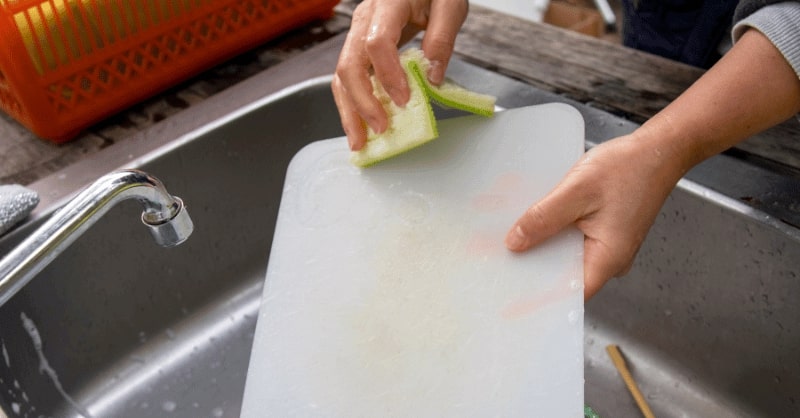
Where to Buy Colour-Coded Chopping Boards in the UK?
You can buy colour-codded chopping boards from the kitchenware supplier. You will also find them in superstores. Furthermore, there are many online shops and websites that offer a wide range of cutting boards. On these websites, you will find chopping boards in different colours, shapes, and sizes. Therefore, you can browse through many options and order whichever is appropriate for you.
What are the Hazards When Using the Chopping Board System?
The main hazard allocated with a chopping board system is that if the system is not maintained properly, a serious case of cross-contamination can occur. Along with that, if the colour is not maintained, different allergens can mix with other food and cause an allergic reaction in the consumer. As a result, it will not only be life-threatening but can be the end of a food business.
Advice and Tips When Using Colour-Coded Chopping Boards
Here are some tips and advice you can use while using colour coded-chopping boards
- Before you start chopping, make sure you choose the right colour board for the product
- If there are new staff in the kitchen, educate them on the colour-code system
- Choose the size of the board according to your workplace and use
How To Use A Chopping Board Safely
You may ask how to safely use a chopping board when cutting ingredients. The answer is, you have to make sure the board is placed in the right manner. If the chopping board is not placed safely, it can cause an accident. Therefore, ensure that the board is put safely on the surface and is not shaky. The best way to do that is by taking damp kitchen paper and putting it under one of the corners of the board.
Another important safety tip is when you cut raw fish or meat, clean it up immediately. It will decrease the chances of cross-contamination.
FAQ:
What colour chopping board for RAW MEAT?
For raw meat, you have to use a red coloured chopping board.
What colour chopping board is for FISH?
The blue coloured chopping board is used to debone, cut and fillet fish. You can also use the blue board for shellfish like scallops or oysters.
What colour chopping board for COOKED MEAT?
The red colour chopping board is used for raw meat. However, a different board is used for cooked meat and is yellow-coloured.
What colour chopping board for NUTS, FRUIT, SALAD and green VEG?
The green-coloured board is used for food products such as nuts, green vegetables and fruits.
What colour chopping board for POTATOES, CARROTS or PARSNIPS?
You should use the brown board for vegetables, especially unwashed root vegetables. Hence, for potatoes, carrots and parsnips, you are supposed to use the brown coloured cutting board
What colour chopping board for TOFU?
Dairy, bread, tofu, and cheese should be cut on white-coloured boards.
What colour chopping board for smoked salmon?
Use the yellow-coloured board for smoked salmon, as the yellow-coloured board is for cooked food.
What colour chopping board for onions?
You can chop onions and garlic on green-coloured cutting boards.
Why Is My Green Chopping Board Losing Its Colour?
Due to using the green board many times and washing it, the board will start to lose its colour.
How Do I Give The Board A Deep Clean?
In order to deep clean your board, you must soak it in water mixed with dish soap overnight. In the morning, clean and rinse it properly.
Final Words
Now that you have gained an overall understanding of the chopping board colour, their meaning, and their importance, it’s time to implement them. All you have to do is find out what colour boards you need and add them to your kitchen equipment. Don’t forget to keep them nice and shiny!
- Available Courses
- Career Bundles73
- Animal care5
- Law8
- Quality Licence Scheme Endorsed111
- Teaching13
- Teaching & Academics Primary27
- Accounting & Finance Primary30
- Training3
- Design14
- IT & Software113
- Healthcare126
- Marketing31
- Health and Safety403
- Construction48
- Electronics25
- Hospitality22
- Health and Social Care219
- Child Psychology37
- Management377
- Business Skills268
- First Aid70
- Employability264
- Safeguarding75
- Food Hygiene103
- Personal Development1338
 Food Hygiene
Food Hygiene Health & Safety
Health & Safety Safeguarding
Safeguarding First Aid
First Aid Business Skills
Business Skills Personal Development
Personal Development







